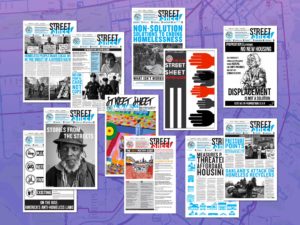Where homeless people fit in the Golden State’s plans to vaccinate residents against COVID-19 has been in flux for the past month. San Francisco officials — as well as houseless San Franciscans — might have to wait longer than expected for things to fall into place.
Last month, the state reorganized the phases of its prioritization plan to immunize Californians. Health care workers — the highest prioritized group in the plan — had already started receiving vaccinations. The next phase of the state’s original plan included unhoused and incarcerated people, who would have been getting shots alongside people aged 65 and over, and essential workers such as educators, child care providers and food and agricultural workers. But as of publication time, they’re not.
That changed when the state announced a new prioritization system early last month. While most unhoused people still qualify — most are over 65 or have disabilities or other underlying health conditions — confusion reigned over homeless people and service providers alike as to how soon vaccine supplies will come their way, not to mention when they will get their shots.
The vaccine would provide protection against the coronavirus and its variants for a population already rendered medically vulnerable from living without stable housing.
When Street Sheet contacted the San Francisco Department of Public Health about when vaccines will be given to homeless folk, DPH replied with a statement from the City’s COVID Command Center, a collaborative of several City departments, saying it’s still waiting for guidance from the state.
On February 24, the department and Command Center released their vaccination plan, which will hinge on mobile teams visiting congregate settings and outdoor sites. These include shelters, permanent supportive housing sites, shelter-in-place and isolation/quarantine hotels, encampments and “safe sleep” sites.
“A guiding principle of this work will be bringing the vaccine to people who are not able to easily access traditional settings like a doctor’s office or pharmacy,” the Command Center said in a statement.
The two groups added that the San Francisco Health Network, UC San Francisco and assorted community organizations would assist in outreach.
Once vaccine recipients receive their first dose, health workers hope to record the vaccinations electronically, follow up on the recipients’ conditions and ensure they receive a second dose. The Centers for Disease Control and Prevention recommend three or four weeks between doses, depending on the vaccination.
A drop-in clinic at Zuckerberg San Francisco General Hospital will also serve unhoused seniors regardless of ZIP code or insurance status, according to the City’s plan.
But what’s still fuzzy is the exact timeline for vaccinations. Brian Edwards, a human rights organizer at the Coalition on Homelessness, which publishes Street Sheet, has been involved in the planning with City officials for the past month.
“There’s no firm date” when the rollout will reach the homeless population, he said. “I suppose it’s because of the supply of the vaccine, but they’re just not moving fast enough.”
Frontline SIP hotel and shelter workers are included in Phase 1A of the vaccine rollout but did not have reliable access to vaccines until February 15th. Based on contacts he made with service providers, Edwards estimated a majority of shelter staff aren’t yet vaccinated, possibly because the information of eligibility hasn’t reached them.
“There should be a big fucking sign [at the shelters]” to direct front-line workers and homeless people to where they can get vaccinated, he said.
One positive development Edwards found is the public health department’s inclusion of permanent supportive housing residents in its plan.
“The people (at DPH) decided that people in PSH sites can be homeless, too,” he said.
###

